Submitted:
25 June 2024
Posted:
27 June 2024
You are already at the latest version
Abstract

Keywords:
1. Introduction
2. Materials and Methods
3. Results
3.1. Investigation of Potential Factors Influencing Emissions, Examination of Concentrations within the Barn, and Estimation of Ammonia Dispersals
3.2. Mitigation Strategy Analysis
4. Discussion and Future Directions
5. Conclusions
Author Contributions
Funding
Institutional Review Board Statement
Data Availability Statement
Conflicts of Interest
References
- Gürlük S., Uzel G., Turan O. Impacts of Cattle and Sheep Husbandry on Global Greenhouse Gas Emissions: A Time Se-ries Analysis for Central European Countries. Polish Journal of Environmental Studies, 2015, 24(1):93-98. [CrossRef]
- Donham K. J., Wing S., Osterberg D., Flora J. L., Hodne C., Thu K. M., Thorne P.S. Community health and socioeconom-ic issues surrounding concentrated animal feeding operations. Environ Health Perspect. 2007, 115(2):317-20. [CrossRef]
- D'Urso, P.R.; Arcidiacono, C.; Cascone, G., Analysis of the Horizontal Distribution of Sampling Points for Gas Concen-trations Monitoring in an Open-Sided Dairy Barn. Animals, 2022, 12, 3258, . [CrossRef]
- Bougouin, A., Leytem A., Dijkstra J., Dungan R. S., And Kebreab E. Nutritional and Environmental Effects on Ammonia Emissions from Dairy Cattle Housing: A Meta-Analysis. J. Environ. Qual., 2016, 45:1123-1132. [CrossRef]
- Qu. Q., Groot J. C. J., Zhang K., Schulte R. P. O. Effects of housing system, measurement methods and environmental factors on estimating ammonia and methane emission rates in dairy barns: A meta-analysis. Biosystems Engineering, 2021, Volume 205, Pages 64-75. ISSN 1537-5110. [CrossRef]
- Rzeźnik W. and Mielcarek P. Greenhouse Gases and Ammonia Emission Factors from Livestock Buildings for Pigs and Dairy Cows. Polish Journal of Environmental Studies. 2016a; 25(5):1813-1821. [CrossRef]
- Sanchis E., Calvet S., Del Prado A., Estellés F. A meta-analysis of environmental factor effects on ammonia emissions from dairy cattle houses. Biosystems Engineering, 2018, Volume 178, 2019, Pages 176-183. ISSN 1537-5110. (https://www.sciencedirect.com/science/article/pii/S1537511018306111). [CrossRef]
- Sommer S.G., Webb J., Hutchings N.D. New Emission Factors for Calculation of Ammonia Volatilization From European Livestock Manure Management Systems. Front. Sustain. Food Syst., 2019, 3:101. [CrossRef]
- Poteko J., Zähner M., Schrade S. Effects of housing system, floor type and temperature on ammonia and methane emis-sions from dairy farming: A meta-analysis. Biosystems Engineering, 2019, Volume 182, Pages 16-28. ISSN 1537-5110. [CrossRef]
- Tullo E., Finzi A., Guarino M. Review: Environmental impact of livestock farming and Precision Livestock Farming as a mitigation strategy. Science of The Total Environment, 2019, Volume 650, Part 2, Pages 2751-2760. ISSN 0048-9697. [CrossRef]
- Fangueiro D., Hjorth M., Gioelli F. (2014). Acidification of animal slurry- a review. Journal of Environmental Manage-ment, 2015, Volume 149, Pages 46-56. ISSN 0301-4797. [CrossRef]
- Hou, Y., Velthof, G. L., & Oenema, O. Mitigation of ammonia, nitrous oxide and methane emissions from manure man-agement chains: a meta-analysis and integrated assessment. Global change biology, 2015, 21(3), 1293-1312. (. [CrossRef]
- Loyon L., Burton C.H., Misselbrook T., Webb J., Philippe F.X., Aguilar M., Doreau M., Hassouna M., Veldkamp T., Dourmad J. Y., Bonmati A., Grimm E., Sommer S.G. Best available technology for European livestock farms: Availability, effectiveness and uptake. Journal of Environmental Management, 2016. Volume 166, Pages 1-11. ISSN 0301-4797. (. [CrossRef]
- United Nations. (2015). Transforming our world: the 2030 Agenda for Sustainable Development. Sustainable Develop-ment knowledge platform. Available online: https://sdgs.un.org/sites/default/files/publications/21252030%20Agenda%20for%20Sustainable%20Development%20web.pdf (accessed on 6 March 2024).
- Maraolo A. E. (2021). Una bussola per le revisioni sistematiche: la versione italiana della nuova edizione del PRISMA sta-tement. Medici Oggi. Available online: http://www.prisma-statement.org/documents/PRISMA%202020%20Italian.pdf?AspxAutoDetectCookieSupport=1 (accessed on 13 December 2023).
- Baldini C., Borgonovo F., Gardoni D., Guarino M. Comparison among NH3 and GHGs emissive patterns from different housing solutions of dairy farms. Atmospheric Environment, 2016, Volume 141, Pages 60-66. ISSN 1352-2310. . (https://www.sciencedirect.com/science/article/pii/S1352231016304800). [CrossRef]
- Mendes L. B., Pieters J. G., Snoek D., Ogink N. W. M., Brusselmane., Demeyer P. Reduction of ammonia emissions from dairy cattle cubicle houses via improved management- or design-based strategies: A modeling approach. Science of The Total Environment, 2017, Volume 574, Pages 520-531. ISSN 0048-9697. https://www.sciencedirect.com/science/article/pii/S0048969716319970. [CrossRef]
- Xu P., Koloutsou-Vakakiss., Rood M. J., Luan S. Projections of NH3 emissions from manure generated by livestock pro-duction in China to 2030 under six mitigation scenarios. Science of The Total Environment, 2017, Volumes 607-608, Pages 78-86. ISSN 0048-9697. [CrossRef]
- Zou B., Shi Z. X., Du S. H. Gases emissions estimation and analysis by using carbon dioxide balance method in natural-ventilated dairy cow barns. Int J Agric & Biol Eng, 2020, 13(2): 41-47. DOI: 10.25165/j.ijabe.20201302.4802.
- Wang X., Ndegwa P. M., Joo H., Neerackal G. M., Harrison J. H., Stöckle C. O., Liu H. Reliable low-cost devices for monitoring ammonia concentrations and emissions in naturally ventilated dairy barns. Environmental Pollution, 2016, Volume 208, Part B, Pages 571-579. ISSN 0269-7491. [CrossRef]
- Chai L., Kröbel R., Janzen H. H., Beauchemin K. A., Mcginn S. M., Bittman S., Atia A., Edeogu I., Macdonald D., Dong R. A regional mass balance model based on total ammoniacal nitrogen for estimating ammonia emissions from beef cattle in Alberta Canada. Atmospheric Environment, 2014, Volume 92, Pages 292-302. ISSN 1352-2310. [CrossRef]
- Saha C.K., Ammon C., Berg W., Fiedler M., Loebsin C., Sanftleben P., Brunsch R., Amon T. Seasonal and diel variations of ammonia and methane emissions from a naturally ventilated dairy building and the associated factors influencing emissions. Science of The Total Environment, 2014, Volumes 468-469, Pages 53-62. ISSN 0048-9697. [CrossRef]
- Wu W., Zhang G., Kai P. Ammonia and methane emissions from two naturally ventilated dairy cattle buildings and the influence of climatic factors on ammonia emissions. Atmospheric Environment, 2012, Volume 61, Pages 232-243. ISSN 1352-2310. [CrossRef]
- Gilhespy, S.L. & Webb, J. & Retter, Andrew & Chadwick, Dave. Dependence Of Ammonia Emissions From Housing On The Time Cattle Spent Inside. Journal Of Environmental Quality. 2006, 35. 1659-67. DOI: 10.2134/Jeq2005.0294.
- Maasikmets M., Teinemaa E., Kaasik A., Kimmel V. Measurement and analysis of ammonia, hydrogen sulphide and odour emissions from the cattle farming in Estonia. Biosystems Engineering, 2015, Volume 139, Pages 48-59. ISSN 1537-5110. [CrossRef]
- DATAMAN, A Database of Greenhouse Gas Emissions from Manure Managementhttps, https://www.dataman.co.nz/.
- D'Urso, P.R.; Arcidiacono, C. Effect of the Milking Frequency on the Concentrations of Ammonia and Greenhouse Gases within an Open Dairy Barn in Hot Climate Conditions. Sustainability 2021, 13, 9235. [CrossRef]
- F. Yang et al., "Ammonia emissions and their key influencing factors from naturally ventilated dairy farms", (2022), Chemosphere 307 (2022) 135747.
- Monteny G.J. And Erisman J.W., "Ammonia emission from dairy cow buildings:a review of measurement techniques, in-fluencing factorsand possibilities for reduction", Netherlands Journal of Agricultural Science 46 (1998) 225-247Netherlands Journal of Agricultural Science 46 (1998)225.
- D'Urso, P.R.; Arcidiacono, C.; Valenti, F.; Janke, D.; Cascone, G. Measuring ammonia concentrations by an infrared pho-to-acoustic multi-gas analyser in an open dairy barn: Repetitions planning strategy. Comput. Electron. Agric., 2023, 204, 107509. [CrossRef]
- D'Urso, P.R.; Arcidiacono, C.; Valenti, F.; Cascone, G. Assessing Influence Factors on Daily Ammonia and Greenhouse Gas Concentrations from an Open-Sided Cubicle Barn in Hot Mediterranean Climate. Animals 2021b, 11, 1400. [CrossRef]
- D'Urso, P.R.; Arcidiacono, C.; Cascone, G. Environmental and Animal-Related Parameters and the Emissions of Ammo-nia and Methane from an Open-Sided Free-Stall Barn in Hot Mediterranean Climate: A Preliminary Study. Agronomy 2021a, 11, 1772. [CrossRef]
- Tabase R. K., Næss G., Larring Y. Ammonia and methane emissions from small herd cattle buildings in a cold climate. Science of The Total Environment, 2023, Volume 903, 166046. ISSN 0048-9697. [CrossRef]
- Hempel S., Saha C. K., Fiedler M., Berg W., Hansen C., Amon B., Amon T. Non-linear temperature dependency of am-monia and methane emissions from a naturally ventilated dairy barn. Biosystems Engineering, 2016, Volume 145, Pages 10-21. ISSN 1537-5110. [CrossRef]
- Ngwabie N.M., Jeppsson K.-H., Gustafsson G., Nimmermark S. Effects of animal activity and air temperature on me-thane and ammonia emissions from a naturally ventilated building for dairy cows. Atmospheric Environment, 2011, Volume 45, Issue 37, Pages 6760-6768. ISSN 1352-2310. [CrossRef]
- Rzeźnik W., Mielcarek P., Rze?nik I. Pilot Study of Greenhouse Gases and Ammonia Emissions from Naturally Ventilat-ed Barns for Dairy Cows. Polish Journal of Environmental Studies. 2016b; 25(6):2553-2562. [CrossRef]
- Pereira J., Misselbrook T. H., Chadwick D. R., Coutinho J., Trindade H. Ammonia emissions from naturally ventilated dairy cattle buildings and outdoor concrete yards in Portugal. Atmospheric Environment, 2010, Volume 44, Issue 28, Pages 3413-3421. ISSN 1352-2310. [CrossRef]
- Zhang G., Strøm J.S., Li B., Rom H.B., Morsing S., Dahl P., Wang C. Emission of Ammonia and Other Contaminant Gas-es from Naturally Ventilated Dairy Cattle Buildings. Biosystems Engineering, 2005, Volume 92, Issue 3, Pages 355-364. ISSN 1537-5110. [CrossRef]
- Rong L., Liu D., Pedersen E. F., Zhang G., Effect of climate parameters on air exchange rate and ammonia and methane emissions from a hybrid ventilated dairy cow building. Energy and Buildings, 2014, Volume 82, Pages 632-643. ISSN 0378-7788. [CrossRef]
- Hassouna, M., Van Der Weerden, T. J., Beltran, I., Amon, B., Alfaro, M. A., Anestis, V., Cinar, G., Dragoni, F., Hutch-ings, N. J., Leytem, A., Maeda, K., Maragou, A., Misselbrook, T., Noble, A., Rych?a, A., Salazar, F., & Simon, P. DATA-MAN: A global database of methane, nitrous oxide, and ammonia emission factors for livestock housing and outdoor storage of manure. Journal of Environmental Quality, 2023, 52, 207-223. [CrossRef]
- Çinar G., Dragoni F., Ammon C., Belik V., Jan van der Weerden T., Noble A., Hassouna M., Amon B. (2023). Effects of environmental and housing system factors on ammonia and greenhouse gas emissions from cattle barns: A meta-analysis of a global data collation. Waste Management. Volume 172, Pages 60-70. ISSN 0956-053X. [CrossRef]
- Reyer, H., Honerlagen, H., Oster, M., Ponsuksili, S., Kuhla, B., & Wimmers, K. (2024). Multi-tissue gene expression profil-ing of cows with a genetic predisposition for low and high milk urea levels. Animal Biotechnology, 35(1). [CrossRef]
- Balcells J. et al., Study of nitrogen fluxes across conventional solid floor cubicle and compost-bedded pack housing sys-tems in dairy cattle barns located in the Mediterranean area: Effects of seasonal variation, Journal of Dairy Science, Vol-ume 103, Issue 11, 2020, Pages 10882-10897, ISSN 0022-0302, (https://www.sciencedirect.com/science/article/pii/S0022030220307074). [CrossRef]
- Calvet S., Gates R. S., Zhang G., Estelles F., Ogink N. W. M., Pedersen S., & Berckmans, D. Measuring gas emissions from livestock buildings: A review on uncertainty analysis and error sources. Biosystems Engineering, 2013, 116(3), 221-231. (. [CrossRef]
- Bobrowski A. B., Willink D., Janke D., Amon T., Hagenkamp-Korth F., Hasler M., Hartung E. Reduction of ammonia emissions by applying a urease inhibitor in naturally ventilated dairy barns. Biosystems Engineering, 2021a, Volume 204, Pages 104-114, ISSN 1537-5110. [CrossRef]
- Bobrowski A. B., Jan van Dooren H., Ogink N., Hagenkamp-Korth F., Hasler M., Hartung E. Reduction of ammonia emissions by using a urease inhibitor in a mechanically ventilated dairy housing system. Biosystems Engineering, 2021b, Volume 204, Pages 115-129, ISSN 1537-5110. [CrossRef]
- Chiumenti A., Da Borso F., Pezzuolo A., Sartori L., Chiumenti R. Ammonia and greenhouse gas emissions from slatted dairy barn floors cleaned by robotic scrapers. Res. Agr. Eng; 2018, 64(1):26-33. [CrossRef]
- Snoek D. J.W., Stigter J. D., Blaauw S. K., Groot Koerkamp P. W. G., Ogink N. W. M. Assessing fresh urine puddle phys-ics in commercial dairy cow houses. Biosystems Engineering, 2017, Volume 159, Pages 133-142. ISSN 1537-5110. [CrossRef]
- VERA. Vera Test Protocol: For Livestock Housing and Management Systems; International VERA Secretariat: Delft, The Netherlands, 2018.
- Aguerre M. J., Wattiaux M. A., Powell J. M., Broderick G. A., And Arndt C. Effect of forage-to-concentrate ratio in dairy cow diets on emission of methane, carbon dioxide, and ammonia, lactation performance, and manure excretion. J. Dairy Sci., 2011, 94:3081-3093. [CrossRef]
- Becciolini V., Leso L., Fuertes Gimeno E., Rossi G., Barbari M., Dalla Marta A., Orlandini S., Verdi L., Nitrogen loss abatement from dairy cow excreta through urine and faeces separation: The effect of temperature and exposure period on NH3 fluxes. Agricultural Systems. 2024. 216:103898. [CrossRef]
- Bluteau C. V., Masse D. I., And Leduc. R. (2009). Ammonia emission rates from dairy livestock buildings in eastern Can-ada. Biosyst. Eng. 103:480-488. [CrossRef]
- Janke, D et al. Calculation of ventilation rates and ammonia emissions: Comparison of sampling strategies for a naturally ventilated dairy barn. Biosystems Engineering, Volume 198, 2020, Pages 15-30.
- Arcidiacono C., Da Borso F., Chiumenti A. (2018). Allevamento animale e sostenibilità ambientale. Vol 1. I principi. A cura di: B. Stefanon, M. Mele, G. Pulina. Franco Angeli editore, Roma. ISBN: 8891761834.
- Charoenkit S., Yiemwattana S. Living walls and their contribution to improved thermal comfort and carbon emission re-duction: A review. Building and Environment, 2016, Volume 105, Pages 82-94, ISSN 0360-1323. [CrossRef]
- Ajami A., Shah S. B., Stikeleather L. F., "Windbreak Wall-vegetative Strip System to Reduce Air Emissions from Mechan-ically-Ventilated Livestock Barns - Part 1: CFD Modeling", Water Air Soil Pollut (2019) 230: 291, . [CrossRef]
- Cervelli E., di Perta E. S., Mautone A. and Pindozzi S., "The landscape approach as support to the livestock manure management. The buffalo herds case-study in Sele plain, Campania region," 2021 IEEE International Workshop on Me-trology for Agriculture and Forestry (MetroAgriFor), Trento-Bolzano, Italy, 2021, pp. 151-156. [CrossRef]
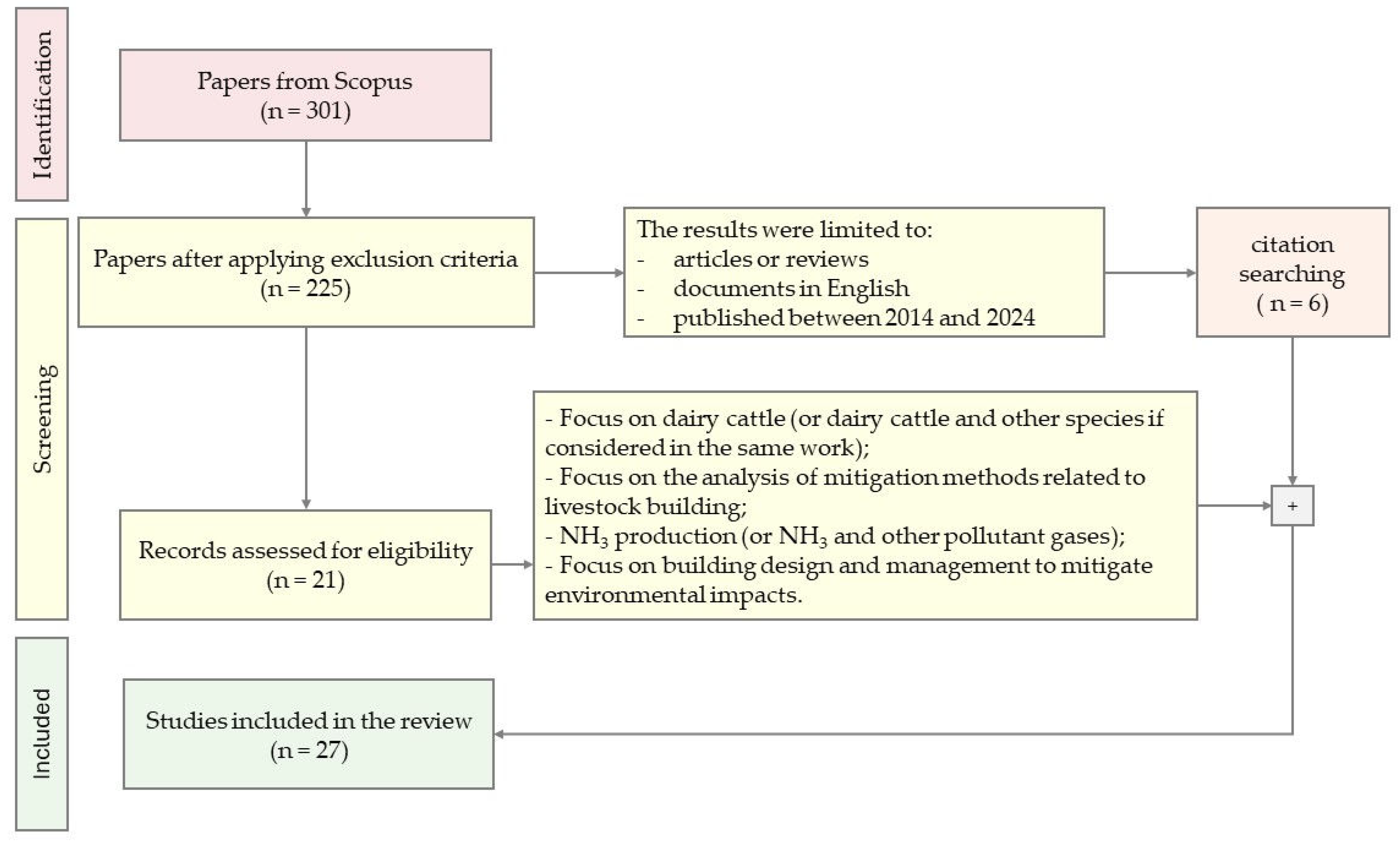
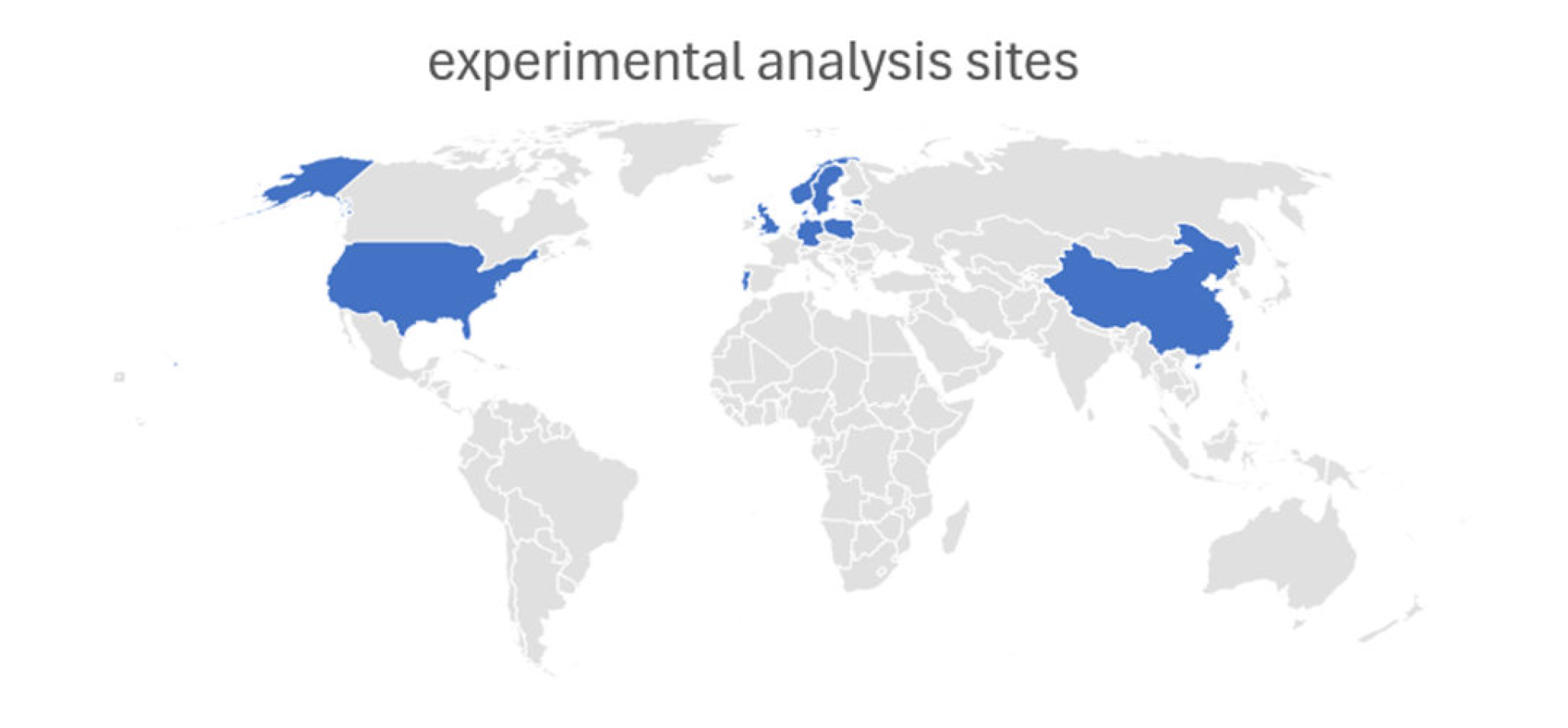
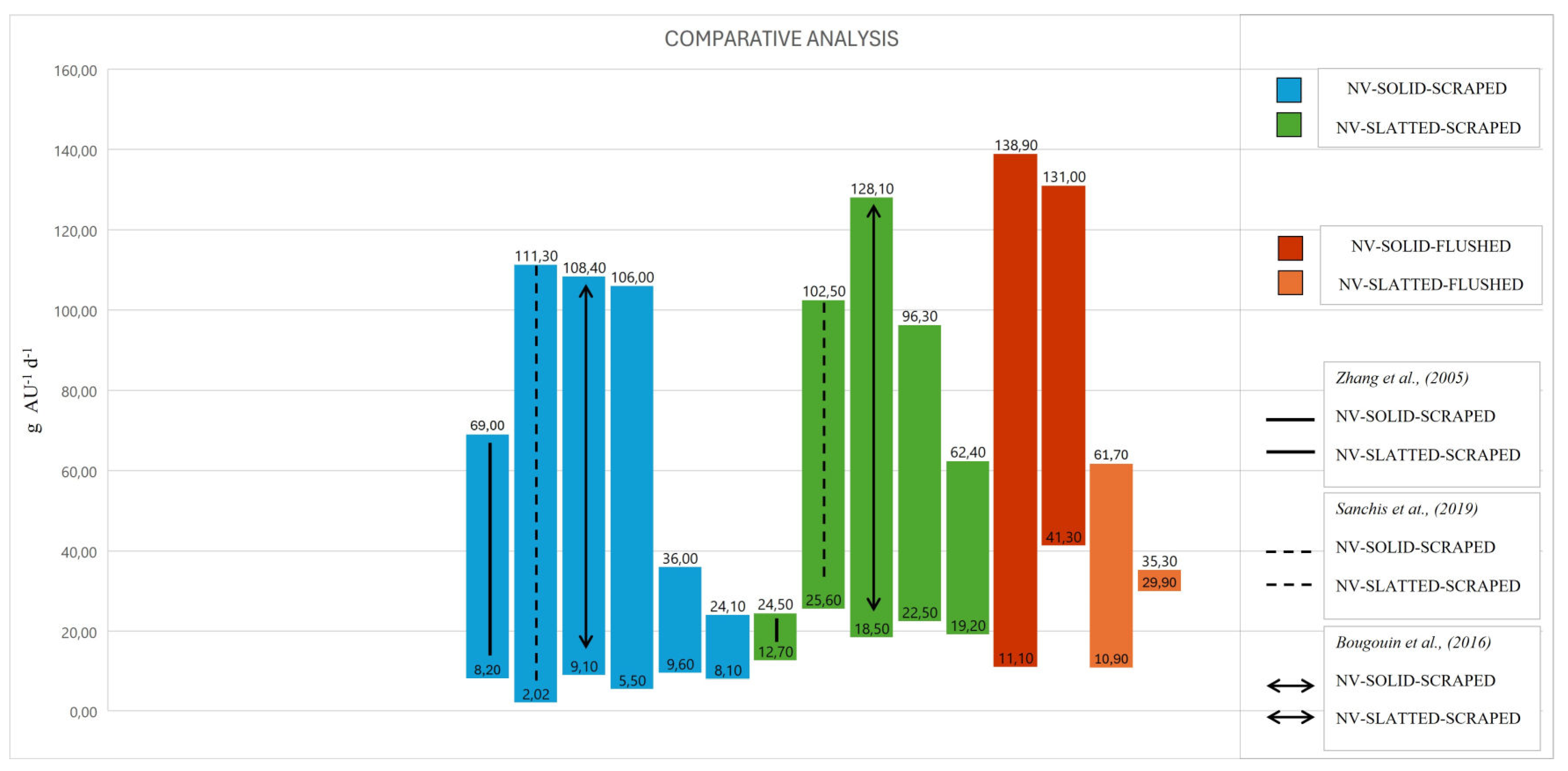



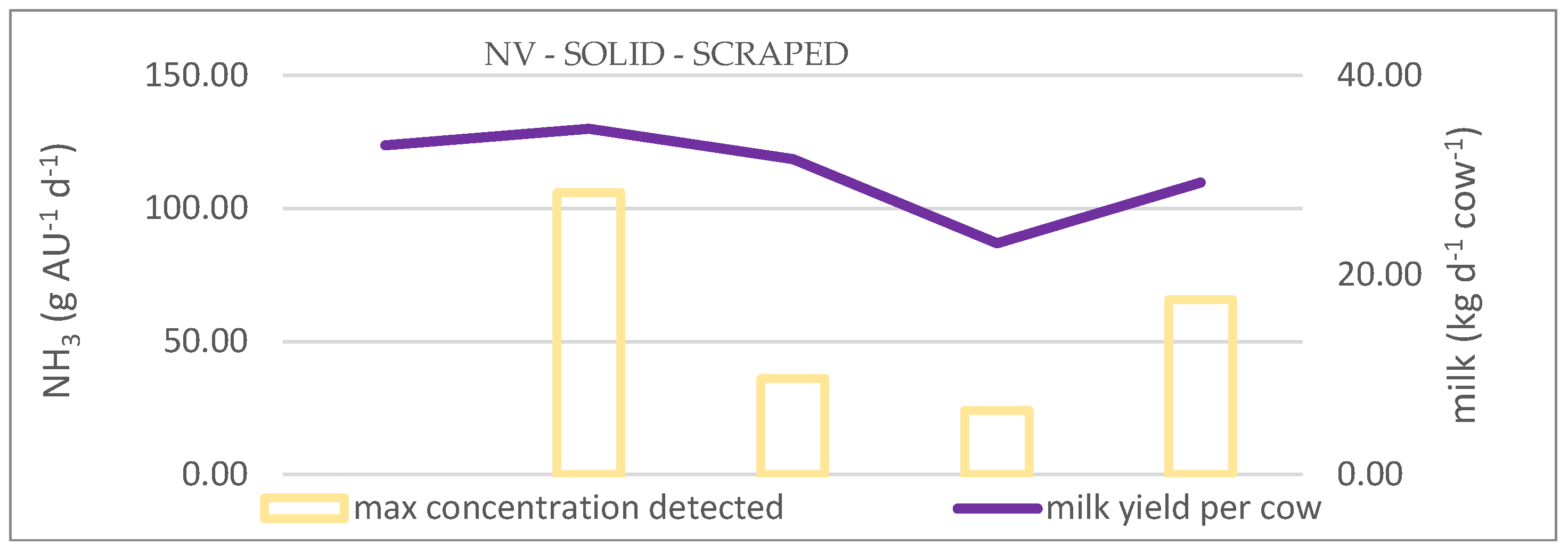
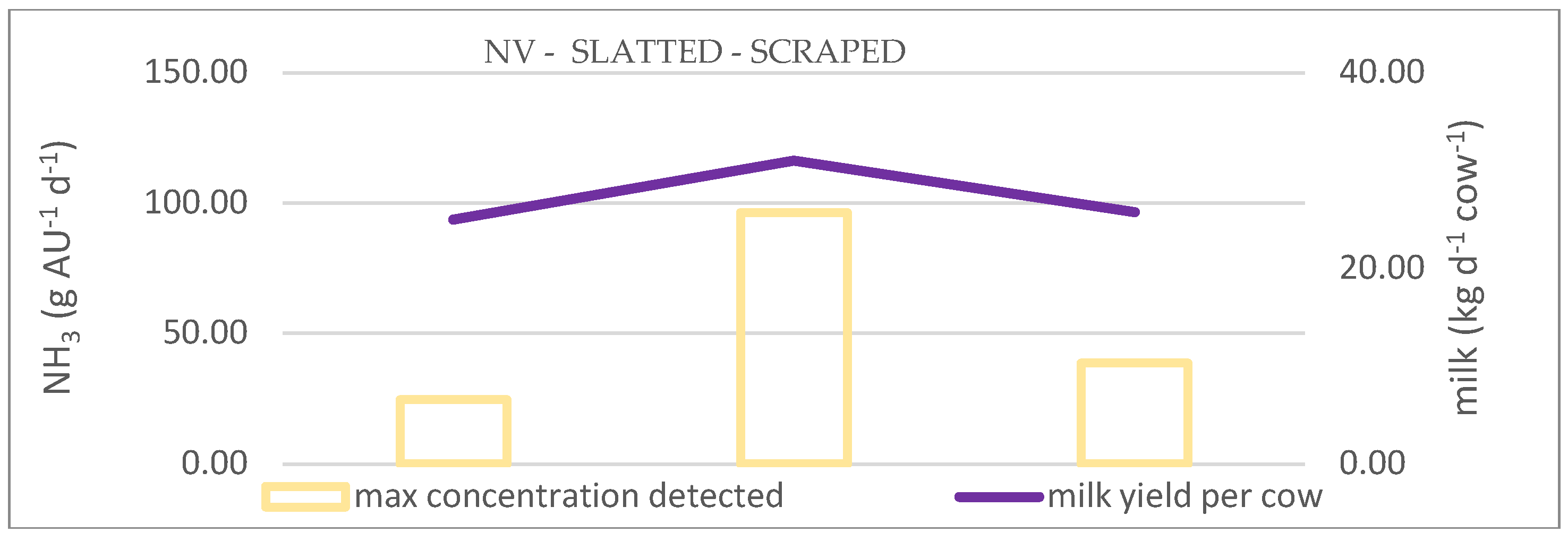
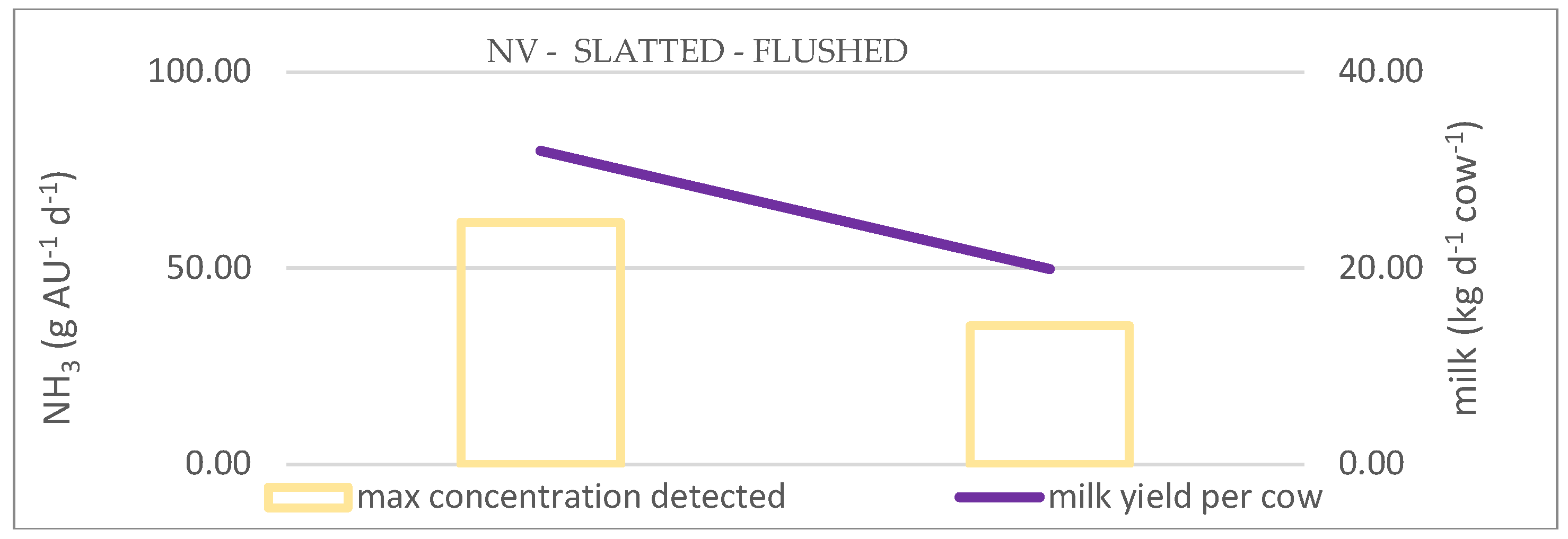

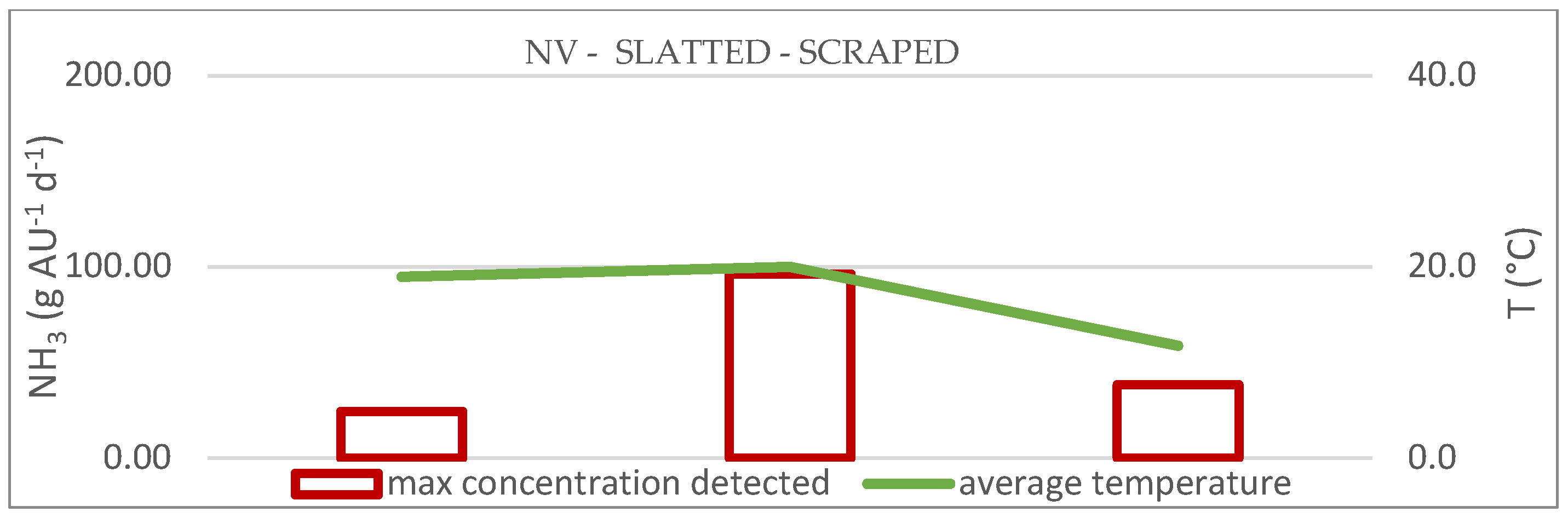

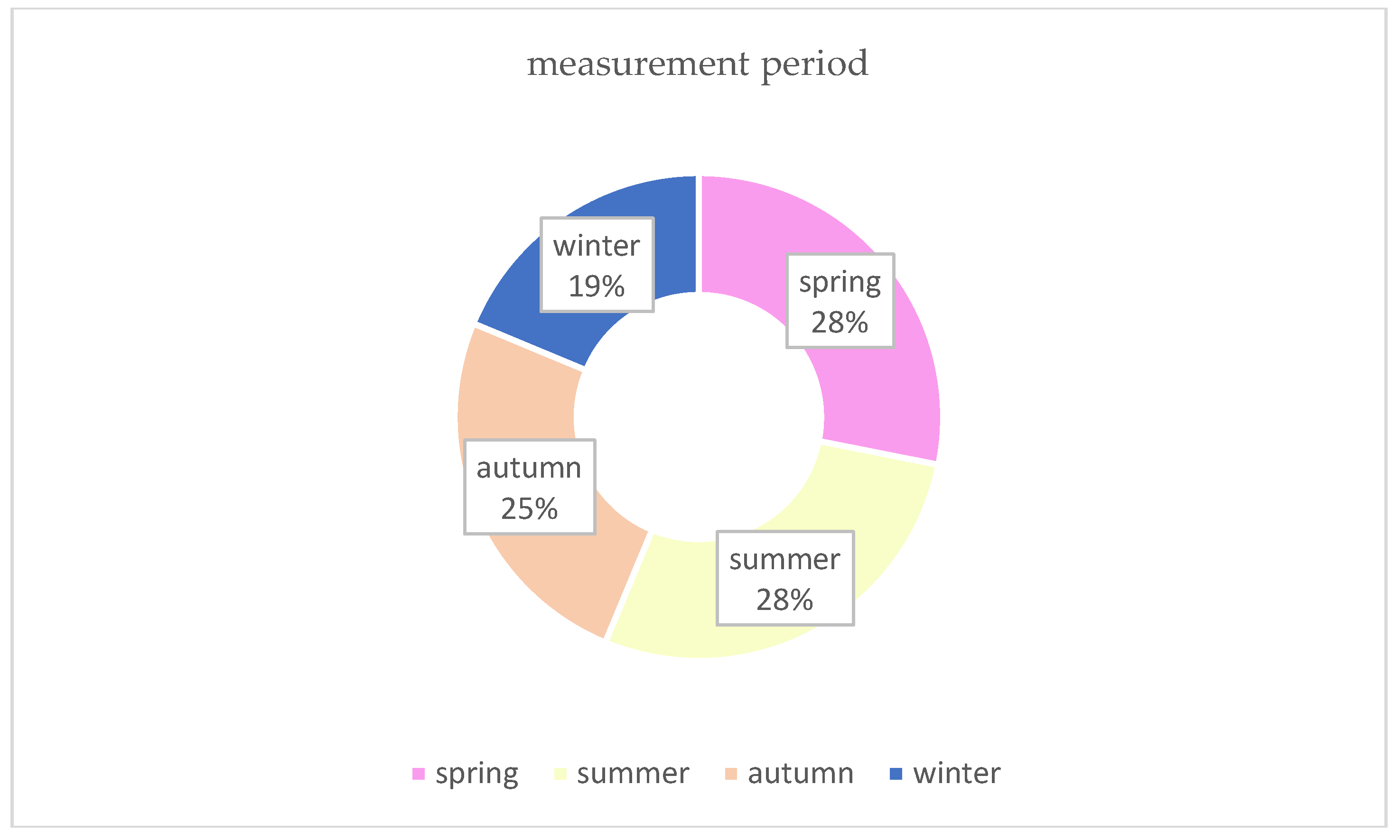
| References | Farm type | Range of NH3 emissions in g AU-1 d-1 | |
| (‘AU’ refers to Animal Unit equalling 500 kg body mass) | |||
| Zhang et al. (2005) | Natural ventilation: | ||
| scraped solid floor | 8.2 – 69.0 g AU-1 d-1 | ||
| flushed solid floor | |||
| scraped slatted floor | 2.7 – 24.5 g AU-1 d-1 | ||
| flushed slatted floor | 10.9 – 61.7 g AU-1 d-1 | ||
| Sanchis et al. (2019) | Natural ventilation: | ||
| scraped solid floor | 2.02 – 111.3 g AU-1 d-1 | ||
| flushed solid floor | 11.1 – 138.9 g cow-1 d-1 | ||
| scraped slatted floor | 25.6 – 102.5 g AU-1 d-1 | ||
| Mechanical ventilation: | |||
| scraped slatted floor | 15.0 – 18.0 g AU-1 d-1 | ||
| Qu et al. (2021) | Ventilation: | ||
| unspecified | |||
| Flooring and manure handling: | |||
| scraped solid | 3.6 - 106 g AU-1 d-1 | ||
| scraped slatted | 23.8 – 27.1 g AU-1 d-1 | ||
| flushed solid | 8.7 – 109.4 g AU-1 d-1 | ||
| flushed slatted | 18.4 – 38.4 g AU-1 d-1 | ||
| Wu et al. (2012) | ventilation: natural | 22.5 – 96.3 g AU-1 d-1 | |
| flooring: slatted | |||
| manure handling: scraped | |||
| Tabase et al. (2023) | Natural ventilation: | ||
| Scraped slatted | 23.52 – 38.64 g AU-1 d-1 | ||
| Mechanical ventilation: | |||
| Scraped slatted | 163.2 – 463.2 g AU-1 d-1 | ||
| Wang et al. (2016) | ventilation: natural | 15.4 – 22.8 g AU-1 d-1 | |
| flooring: | |||
| unspecified | |||
| manure handling: flushed | |||
| Zou et al. (2020) | ventilation: natural | 24.0 – 56.6 g AU-1 d-1 | |
| flooring: | |||
| unspecified | |||
| manure handling: scraped | |||
| Saha et al. (2014) | ventilation: natural | 5.5 – 106.1 g AU-1 d-1 | |
| flooring: solid | |||
| manure handling: scraped | |||
| Hempel et al. (2016) | ventilation: natural | 0.0 – 96.0 g AU-1 d-1 | |
| flooring: unspecified | |||
| manure handling: unspecified | |||
| Ngwabie et al. (2011) | ventilation: natural | 9.6 – 36.0 g AU-1 d-1 | |
| flooring: solid | |||
| manure handling: scraped | |||
| Maasikmets et al. (2015) | ventilation: natural | tie housing cow building: 6.4 ± 0.47 g AU-1 d-1 | |
| flooring: solid | loose housing cow barn: 7.8 ± 4.01 g AU-1 d-1 | ||
| manure handling: removed by tractor | |||
| Bougouin et al. (2016) | Natural ventilation: | ||
| Scraped solid | 9.1 – 108.4 g AU-1 d-1 | ||
| Scraped slatted | 18.5 – 128.1 g cow-1 d-1 | ||
| Flushed solid | 41.3 – 131.0 g AU-1 d-1 | ||
| Flushed slatted | 29.8 g cow-1 d-1 | ||
| Mechanical ventilation: | |||
| Scraped solid | 8.0 g AU-1 d-1 | ||
| Gilhespy et al. (2006) | ventilation: natural | 8.1 – 24.1 g AU-1 d-1 | |
| flooring: solid | |||
| manure handling: scraped | |||
| Rzeźnik et al. (2016b) | ventilation: natural | ||
| flooring: slatted | |||
| Manure handling: | |||
| stored under slatted floor | 12.5 – 17.5 g AU-1 d-1 | ||
| scraped | 12.2 – 24.0 g AU-1 d-1 | ||
| removed by tractor | 6.0 – 22.0 g AU-1 d-1 | ||
| Pereira et al. (2010) | ventilation: natural | ||
| Flooring and manure handling: | |||
| Scraped solid | 65.8 g AU-1 d-1 | ||
| Flushed slatted | 29.9 – 35.3 g AU-1 d-1 | ||
| Rzeźnik et al. (2016a) | ventilation: unspecified | 26.7 g AU-1 d-1 | |
| flooring: | |||
| Scraped solid | 0.1 – 1.7 g AU-1 d-1 | ||
| Scraped slatted | |||
| Hassouna et al.* (2022) | Natural ventilation: | ||
| Flooring: | |||
| Slatted floor | 3.36 – 89.2 g AU-1 d-1 | ||
| Solid floor | 1.72 - 99.7 g AU-1 d-1 | ||
| Mechanical ventilation: | |||
| Flooring: | |||
| Slatted floor | 0.04 - 98.8 g AU-1 d-1 | ||
| Solid floor | 0.05 – 59.3 g AU-1 d-1 | ||
| Manure handling: unspecified | |||
| *This article contains the description of a global database that indicate NH3 emission values expressed as % of the total number of values for each gas analysed. The reported ranges have been derived from the ‘DATAMAN’ database [26] accessed at https://www.dataman.co.nz/DataManHousings. | |||
| Cinar et al., (2023) | Ventilation, flooring and manure handling: unspecified* | 0.0 - 146.7 g AU-1 d-1 | |
| * This article states that NH3 emissions differ between types of housing, but not between types of flooring. | |||
| Poteko et al., (2019) | ventilation: unspecified | ||
| flooring: | |||
| solid | 1.1 – 191.2 g AU-1 d-1 | ||
| slatted | 4.0 – 85.0 g AU-1 d-1 | ||
| manure handling: unspecified | |||
| Sommer et al., (2019) | Ventilation and manure handling: | ||
| unspecified | |||
| flooring: | |||
| solid | 12.8 – 55.4 g AU-1 d-1 | ||
| slatted | 0.8 – 88.0 g AU-1 d-1 | ||
| References | Farm type | Mitigation strategies | % reduction |
|---|---|---|---|
| Mendes et al. (2017) | ventilation: natural flooring: solid manure handling: scraped and flushed |
· manure acidification · floor scraping · floor scraping and washing · floor design |
27% 17% - 22% 20% - 27% - |
| Fangueiro et al. (2015) | ventilation: not available flooring: not available manure handling: not available |
· manure acidification |
37% |
| Hou et al. (2015) | ventilation: natural flooring: solid; slatted and deep litter manure handling: crusting; straw cover; artificial film and acidification |
· reduction of the protein content of the animal diet · external slurry storages via acidification · cover of stored manure with straw or artificial film |
24 – 65% 83% 78 – 98% |
| Baldini et al. (2016) | ventilation: natural flooring: solid; rubber matted and slatted manure handling: scraped and flushed |
· Feeding alley: · Flushing system (percentage of reduction compared to the worst condition: scraper on concrete floor) · Resting area: - Rubber mat-bedded cubicles (percentage of reduction compared to the worst condition: Straw-bedded cubicles) |
80% 20% |
| Snoek et al. (2017) | ventilation: unspecified; flooring: solid and slatted manure handling: scraped and manually cleaned | · floor design · use of scrapers |
- 50 – 70% |
| Xu et al. (2017) | ventilation: unspecified; flooring: unspecified; manure handling: unspecified | · low nitrogen food (LNF) · manure management |
18.9 - 37.3% |
| Tullo et al. (2019) | ventilation: natural and mechanical; flooring: unspecified; manure handling: unspecified | · precision Livestock Farming (PLF) |
27 – 41% |
Disclaimer/Publisher’s Note: The statements, opinions and data contained in all publications are solely those of the individual author(s) and contributor(s) and not of MDPI and/or the editor(s). MDPI and/or the editor(s) disclaim responsibility for any injury to people or property resulting from any ideas, methods, instructions or products referred to in the content. |
© 2024 by the authors. Licensee MDPI, Basel, Switzerland. This article is an open access article distributed under the terms and conditions of the Creative Commons Attribution (CC BY) license (http://creativecommons.org/licenses/by/4.0/).





